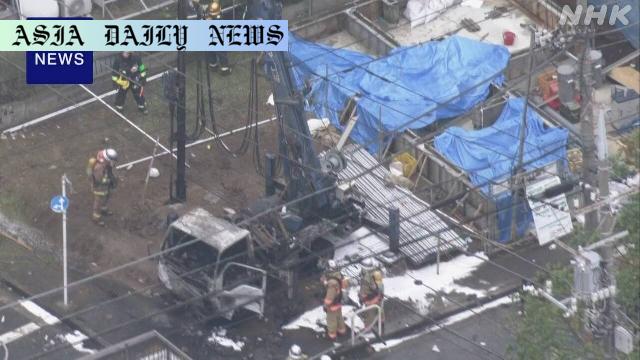Explosion: Police suspect a buried acetylene cylinder caused a Tokyo blast, injuring 10 people and damaging 38 buildings.
Key Point 1: An explosion occurred at a housing construction site in Tokyo, injuring 10 people and affecting 38 buildings.
Key Point 2: The suspected cause was a buried acetylene gas cylinder, likely left abandoned at the site.
Key Point 3: Authorities emphasize safe disposal of high-pressure gas cylinders to prevent similar incidents.
Key Point 4: Acetylene gas, used in metal work, burns at over 3,000°C and can spark dangerous explosions under extreme conditions.

Explosion at Tokyo Housing Construction Site
In a startling incident that shook the Edogawa Ward in Tokyo, an explosion at a residential construction site left 10 individuals with minor injuries and caused significant damage to nearly 40 nearby buildings. The explosion occurred on Tuesday morning when workers were driving piles into a previously unused plot of land, which was earlier functioning as a parking lot. The construction site saw a massive fire erupt, leaving a vehicle badly burnt and disfiguring walls and windows of surrounding homes and shops.
While minor injuries were reported, affecting both construction workers and local residents with throat and ear pains, the situation could have been far graver. The explosion has raised immediate alarms about safety and proper protocols in urban construction zones. Tokyo’s emergency responders and law enforcement agencies are working tirelessly to understand the factors that led to this avoidable event.
Burst Gas Cylinder: A Likely Culprit
The investigation points to acetylene gas as the primary suspect behind the devastation. Officials have linked the explosion to a buried cylinder containing acetylene gas, found approximately 60 centimeters under the surface. Acetylene gas, known for its extremely high combustion temperature of more than 3,000 degrees Celsius, is commonly used to weld and cut metals. Experts from the high-pressure gas safety association believe the incident might have been triggered by damage to the cylinder, leading gas leakage and combustion.
Acetylene cylinders, under typical circumstances, do not pose significant explosion risks unless acted upon by powerful external forces such as heavy shocks or unintended ignitions. This revelation highlights the importance of stringent safety and disposal protocols for such hazardous materials. Gas-related industrial organizations stress that gas containers must either be disposed of safely as per regulatory protocols or returned if rented, something seemingly overlooked in this situation.
The Rising Risk of Buried High-Pressure Gas Cylinders
The Edogawa incident points to a growing concern in Tokyo Prefecture and other urban centers about buried gas cylinders becoming latent risks during new construction projects. Several acetylene cylinders get discovered annually, with many attributed to neglectful abandonment by firms unwilling to deal with time-consuming disposal requirements. Experts speculate that the discovered cylinder at Edogawa was buried intentionally by a prior user who viewed its disposal as inconvenient or costly.
Despite incidents, recovery associations in Tokyo emphasize that explosions during cylinder retrieval or recycling remain exceedingly rare. Nonetheless, this event underscores the need for construction companies and property developers to go the extra mile in surveying and auditing land earmarked for residential or infrastructure projects. The safety guidelines for disposal and recovery not only prevent such cataclysmic episodes but also ensure broader compliance with environmental and industrial laws.
The Call for Stricter Safety Enforcement
This alarming incident serves as a wake-up call for governments, regulatory agencies, and private organizations. The presence of aging or illicitly disposed high-pressure gas containers lurking beneath construction sites is not just a compliance issue—it is a public safety hazard. Experts recommend stricter penalties for violating firms and incentivization for proper disposal practices. Educational campaigns can also be carried out targeting workers and companies to recognize and act responsibly regarding hazardous materials.
Ensuring rigorous checks at construction sites coupled with mandatory prior land usage audits should become a long-term standard. In Edogawa’s case, public resources were strained to manage what was likely a preventable incident. City officials and law enforcement must put into place actionable frameworks to minimize recurrence in future projects.



Commentary
Lessons to Learn from the Edogawa Incident
The explosion that rocked Tokyo’s Edogawa Ward is more than an isolated event; it is a symptom of a larger systemic issue that needs immediate attention. As cities develop and construction activities expand, the unwelcome discovery of hazardous left-behind objects such as acetylene cylinders becomes increasingly inevitable. This incident should remind us all about the dire consequences of negligence regarding high-pressure gases and their proximity to densely populated areas.
Importance of Stringent Safety Protocols
What stands out in this tragedy is not just the immediate damage but the ease with which such an incident could have been avoided. Proper disposal of high-pressure gas cylinders, adherence to safety protocols, and regular audits of construction sites could have prevented this blast. Workers as well as local government agencies must place a greater focus on creating an enforceable framework surrounding construction safety, especially concerning hazardous materials. Education, strict oversight, and incentivizing compliance should be a trifecta for addressing these rising risks.
A Collective Responsibility
The Edogawa blast also sheds light on corporate accountability. Firms utilizing hazardous materials must be held accountable for the proper handling and disposal of dangerous goods. While laws and regulations exist, enforcement and compliance checks often lack the robustness needed for the complexities of urban development. Perhaps encouraging whistleblowing, heavier fines, or implementing positive reinforcement policies are steps authorities should consider.
Respective municipal bodies and private associations working in specialized trades such as gas handling must collaborate to avoid future incidents by exploring technological opportunities or digitized databases tagged to old industrial sites. We must ensure greater harmony between development and safety. Public health and safety are non-negotiable.